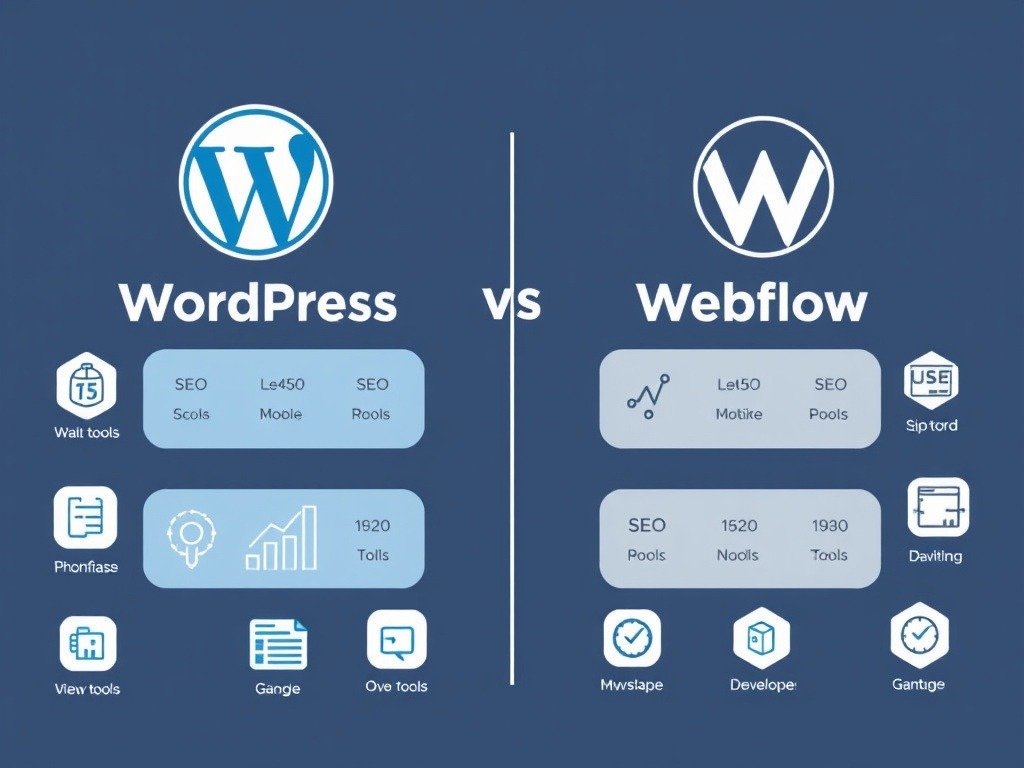
The WordPress versus Webflow debate isn’t restricted to simple design preferences anymore. Rather, the real question focuses on which system can deliver better measurable SEO outcomes.
At Matter Solutions, we’ve found that your platform choice directly influences how quickly you can implement technical SEO improvements. We’ve helped clients migrate between systems and seen how these platforms handle search optimisation mechanics.
In this guide, we’ll cover WordPress and Webflow’s technical SEO capabilities, content management efficiency, and real-world ranking factors. You’ll also learn which platform can give your team more control over SEO elements, plus probable costs and learning curves.
Ready to find out about the platform that ensures better search performance for your site? Let’s begin.
WordPress vs Webflow: A CMS Comparison for Core SEO
The main difference between WordPress and Webflow lies in how much control and convenience they allow you to have. WordPress operates as an open ecosystem where you can manage every aspect of your site. Meanwhile, Webflow is a closed environment with built-in optimisations, yet it offers limited flexibility.
If you understand these structural differences in WordPress and Webflow, you’ll easily choose the system that will work the best with your SEO strategy.
We’re going to dig deeper into these Content Management System (CMS) platforms now. We’ll explain them one by one, starting with WordPress.
The Unmatched Flexibility of an Open Source CMS in WordPress
Do you know it’s possible to get total control over your CMS? Yeah, WordPress gives you that with your website’s codebase. You can modify your database queries, adjust server configurations, and implement custom SEO solutions that are impossible with closed systems.
And when you work with technical SEO, you realise how valuable it is to have this much control over your site’s code. You can even take the next step towards advanced technical SEO since you have direct code access.
And the pricing? Zero. WordPress.org is totally free.
That said, if you fail to manage your WordPress sites properly, they’ll accumulate plugin conflicts, redundant code, and security vulnerabilities. These issues directly impact your Core Web Vitals and search performance.
Webflow’s Predictable System and Code Out of the Box
Webflow works based on automated code generation. This platform generates semantically clean HTML and CSS by itself. In our experience, Webflow sites typically achieve better initial Core Web Vitals scores without additional optimisation.
But this CMS has some downsides. You can’t implement advanced caching strategies, custom database optimisations, or complex redirect rules on your site. It’s bad for enterprise SEO strategies.
Now the pricing. Webflow has a free starter plan with heavy limitations. The basic plan removes some of those limitations, but it’s at least $18 (USD) per month. You have other plans, too, that you can purchase based on your requirements.
Hands-On Search Engine Optimisation
You may have found your preferred CMS platform, still your technical work will determine where you rank in searches. In other words, the real test of your platform is when you need to implement specific SEO tasks.
Mind you, these tasks directly impact how search engines crawl and index your content. So you have to be careful with those.
We’ll go through how WordPress and Webflow handle the technical work that keeps your site visible to search engines.
Managing On-Page Elements and Duplicate Content
Here’s the thing… The on-page optimisation of your website requires precise control over meta tags, canonical URLs, and structured data. That’s why your platform’s flexibility in managing these elements affects both implementation speed and long-term maintenance requirements.
Here’s how both platforms handle important on-page elements:
- WordPress: This free CMS system relies on plugins or custom functions for granular control over tags. The functions may add dependencies, but they allow you to have complex rule sets for large sites with different content types.
- Webflow: You get a user interface for canonicals and metadata with Webflow. Simplified implementation like this provides less flexibility for complex conditional rules or bulk operations.
Site Speed and Its Impact on Google Search Engine Optimisation
Unless you’re stuck in 2005, you already know how much your site speed can influence your search ranking positions. And it gets interesting here, because WordPress and Webflow take fundamentally different approaches to these performance optimisations.
The speed optimisation process of the two CMS:
- WordPress: Your WordPress site’s speed depends on the quality of your chosen host, caching configurations, and image optimisation plugins. They should work together effectively to give you the best loading speed.
- Webflow: The platform’s integrated hosting infrastructure, built-in asset delivery system, and automatic CDN distribution mostly manage your site’s performance.
- Developer Task: In WordPress, developers should assemble and actively manage important performance components. However, Webflow handles optimisation automatically but limits your customisation options.
Strategic Scalability and the Best CMS Choice
If your business plans to publish hundreds or thousands of pages over the next few years, your platform choice becomes a make-or-break decision. So, before you choose your CMS platform, you must have an idea about how your SEO strategy will evolve.
We’ll explore below how WordPress and Webflow handle growth as well as advanced technical requirements.
Scaling Your Content Creation Efforts
The efficiency of your content workflow and the technical ability to manage thousands of pages without performance degradation are important for long-term success. It’s because content scalability affects everything from publishing speed to search engine crawling efficiency.
Let’s see how WordPress and Webflow perform in these aspects.
Building a Content Hub in WordPress
WordPress custom post types allow you to build highly structured, scalable content repositories. You can create unlimited content types with custom fields, taxonomies, and relationships between different content pieces.
And here’s another cool thing: Marketing teams can build programmatic SEO strategies that generate thousands of optimised pages automatically.
While all of that is happening, a well-configured WordPress database structure can handle millions of posts without any performance degradation in the back-end.
Webflow’s Collection-Based Structure
Webflow organises content through CMS Collections. However, you read earlier that it comes with limits based on your pricing tier. The basic plan allows 50 CMS items, while higher tiers can extend to 20,000 items. Each CMS item may represent a blog post or a recipe on your site.
For businesses planning long-term content expansion, these collection limits can cause serious bottlenecks. You’ll need expensive plan upgrades or platform migration down the line.
Advanced Integration via a Headless CMS
Modern businesses are rapidly adopting headless CMS systems for maximum performance and flexibility. But what does headless mean? Well, it involves separating your back-end content management from a custom front-end interface.
The reason behind using headless systems is to ensure better loading speed and a good user experience. Both WordPress and Webflow support headless implementations, but the execution complexity and customisation options are different between them.
First, WordPress’s ecosystem. It allows for more custom integrations with business systems like CRMs, inventory management, and marketing automation platforms.
On the flip side, Webflow relies more on standard API connections and middleware solutions for complex business system integrations.
Making the Right Choice for Your Business
Your website’s platform selection will impact every SEO decision you’ll make for years. Both WordPress and Webflow offer good systems for better search performance. However, they still serve different business needs and technical requirements effectively.
In this article, we’ve examined core structural differences between WordPress and Webflow. We also talked about these platforms’ hands-on optimisation capabilities and scalability factors.
We at Matter Solutions specialise in platform-specific SEO strategies that maximise your chosen system’s potential. Contact us today to accelerate your search rankings and drive qualified traffic to your business.





